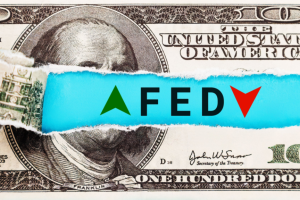
The coolest CPI print yet … Moody’s drops U.S. credit to “negative” … the “outright bad” 30-year Treasury auction … a special AI event tonight with Eric Fry
Stocks are exploding higher as I write Tuesday morning, cheering the cool Consumer Price Index (CPI) data released this morning – and rightfully so. It was a fantastic print.
Whereas economists surveyed by Dow Jones had been looking for a gain of 0.1% on the month and 3.3% on the year, and respective numbers came in at 0% and 3.2%.
Even “core” inflation, which strips out volatile food and energy prices, came in below estimates. It increased 0.2% monthly and 4% yearly against the forecast of 0.3% and 4.1%.
Wall Street is looking at this data, concluding that the Fed’s interpretation will be “no more hikes needed.”
But Wall Street is looking ahead even farther.
As these data come in cooler, it’s less about whether the Fed will need to hike one more time, and more about when the Fed will begin cutting.
***What a difference one day can make
Yesterday, I went to the CME Group’s FedWatch Tool to see how Wall Street traders were assessing rate cuts in 2024.
As of yesterday afternoon, traders put the heaviest odds – 28.8% – on three quarter-point cuts in 2024. That would mean we end next year with a fed funds target rate of 4.50% – 4.75%.
Well, based on this morning’s cool CPI data, Wall Street traders are frantically recalibrating.
As you can see below, the going expectation is now four quarter-point cuts next year, dropping the fed funds target rate to 4.25% – 4.50% by December. This has a 30% probability as I write.

Yesterday, as I researched stories for today’s Digest, I came across an article on Bloomberg highlighting how the investment bank UBS is calling for enormous rate cuts next year – even more than four.
From Bloomberg:
The Federal Reserve will cut interest rates by 275 basis points next year, nearly four times more than what markets are pricing, strategists at UBS Investment Bank predict.
Behind this outsized rate-cut projection is UBS’ forecast of a continued decline in inflation that enables the central bank to ease policy with large cuts, not just small quarter-point declines. Today’s CPI data is certainly a good start.
***Meanwhile, the U.S. government increasingly resembles your unemployed brother-in-law who needed to borrow “a few bucks” …
…And now you’re pretty sure you’ll never see that money again.
On Friday, the credit rating agency Moody’s lowered its credit rating for the U.S. from “stable” to “negative.”
From CNBC:
The ratings agency has affirmed the long-term issuer and senior unsecured ratings of the U.S. at Aaa.
“In the context of higher interest rates, without effective fiscal policy measures to reduce government spending or increase revenues,” the agency said. “Moody’s expects that the US’ fiscal deficits will remain very large, significantly weakening debt affordability.”
This comes as no surprise to regular Digest readers. We’ve spilled plenty of ink here discussing the deteriorating condition of the U.S. government – which is accelerating thanks to today’s lofty fed funds rate.
This downgrade comes on the eve of another possible government shutdown later this week. The government is funded through this Friday but, per usual, our politicians are at a stalemate as to how to resolve a spending bill for funding after the deadline.
If history repeats, there will be an 11th hour compromise that keeps the lights on. But when it comes to whether lawmakers will spend your money with greater responsibility and discipline, we’re not holding our breath.
***While we’re unconcerned about the government going broke, the more pressing issue for your portfolio relates to government bond yields
The worse the government’s financial position, the greater the risk that buyers of our government’s debt will require higher yields to compensate for the perception of greater risk.
The higher that bond yields go, the more challenging the environment for stocks.
For example, below we look at the 30-year Treasury yield (in black) and the S&P (in green) since mid-July. The inverse correlation is obvious.

For months now in the Digest, we’ve been tracking the government’s outsized issuance of bonds. The government has had to do this to fund its increasingly large deficits and spending obligations.
Of course, Econ 101 tells us that when we flood a market with something, its price tends to drop (which, for bonds, means yields must rise).
With this context, let’s turn to a Barron’s article from last Thursday, titled “30-Year Treasury Auction Breaks Bad, Sinks Stock Market”:
The Treasury’s auction of 30-year bonds on Thursday went about as badly as it could, indicating investors are reluctant to own long-dated government securities.
At the auction of government debt that matures in 30 years, investors were awarded 4.769% in yield, 0.051 percentage point higher than the yield in pre-auction trading.
The difference between the two yields—called a tail—indicated a weak auction where the U.S. government had to entice investors with a premium over the market to buy their debt.
Primary dealers, who buy up supply not taken by investors, had to accept 24.7% of the debt on offer, more than double the 12% average for the past year.
“Today’s 30 yr auction was outright bad,” Peter Boockvar, chief investment officer at Bleakley Financial Group, said in a research note.
Now, this was last Thursday.
And what is the 30-year Treasury yield (and the 10-year Treasury yield) doing today in the wake of this morning’s CPI print?
Plummeting.
This prompts a question…
***Which macro variable will win the battle for stock market direction in 2024?
As I write, there’s no debate – the expectation of rate cuts from the Fed is winning as stocks explode higher.
The 10-year Treasury yield is back under 4.50%. Yet, at the same time, the broad trend remains “up” as it’s been for several years now.

So, the question for 2024 and beyond is “what influence will drive the market?”
Will it be our government’s deteriorating financial situation (which drives yields higher), or lower rates from the Fed (which pushes yields lower)?
Given that lower rates from the Fed will ease pressure on our government’s mindboggling debt service payments, the edge goes to lower rates from the Fed – for now, at least.
But let’s not get ahead of ourselves in our analysis.
For now, the bottom line is that inflation is cooling, Wall Street is celebrating, and we don’t want to miss this market surge. Let’s trade it higher.
***Switching gears, despite the run-up in artificial intelligence stocks this year, longer-term investors still have an enormous opportunity today.
While certain AI stocks have exploded higher in 2023, the broader AI sector remains in its infancy. And that means the long-term wealth creation potential is extraordinary.
For more, let’s jump to our macro expert Eric Fry:
We’re only in the very early stages of this trend, and as I’ve said in the past, catching just one of these megatrends at the right time (i.e., now) can lead to life-changing gains…
Clearly, a “Wild, Wild West” of AI technologies is unfolding before us. More companies than we could have thought possible are putting their chips into this trend – in more ways than we thought possible.
Most of the early-stage AI initiatives are still too new and/or small-scale to make any significant contribution to a company’s bottom line… yet.
But they demonstrate that the AI megatrend is real, powerful, and gaining momentum by the day.
Fortunately for we investors, this megatrend is still in its infancy, which means it will nurture a growing number and variety of investment opportunities over the coming months and years.
Tonight at 7 PM Eastern, Eric is going live at his Extreme Alpha 2.0 Summit to dive into this enormous AI opportunity. He’ll also be pulling back the curtain on how he’s incorporating AI into his own market approach to enhance his recommendations.
Just click here to reserve your seat for tonight’s free event.
Here’s Eric to take us out:
I don’t often participate in high-profile events like this.
Most of the time, I prefer to stay behind the scenes, analyzing the markets, so that I can pinpoint the kinds of stocks that can deliver market-beating returns.
That’s the only way I know to help my readers excel in the markets and turn their financial goals into realities.
And so far, so good.
Those readers who’ve followed my recommendations since the ‘90s have had more than 40 opportunities to capture 1,000%-plus gains. But I think we’re just getting started…
There are many more 1,000% gains to come.
Join me tonight to learn more.
Have a good evening,
Jeff Remsburg




